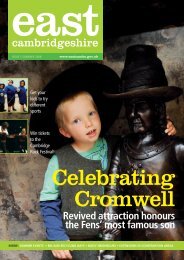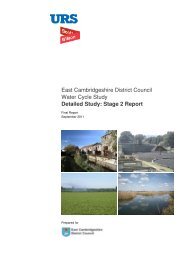6. Soham Conservation Area - East Cambridgeshire District Council
6. Soham Conservation Area - East Cambridgeshire District Council
6. Soham Conservation Area - East Cambridgeshire District Council
You also want an ePaper? Increase the reach of your titles
YUMPU automatically turns print PDFs into web optimized ePapers that Google loves.
10.5 Roof forms<br />
For the most part slate roofs are of a shallow pitch and often hipped.<br />
Steeper pitches often indicate that the property was originally thatched,<br />
although steeper pitches are also typical of tiled roofs. Parapets,<br />
particularly on gables, are relatively common and lean to additions and<br />
gables add incident to the simple roof forms, but are not frequently<br />
used. A number of properties have dormers and those in the 1.5 storey<br />
properties tend to be cat-slides, but a few are gabled or flat. Dormers in<br />
grander properties are a mixture of half, hipped or flat.<br />
10.6 Location on the plot<br />
Most traditional properties sit on, or near to, the back of the footpath<br />
and parallel to the road with a wide frontage, although the 19 th century<br />
terraces have deeper plans and narrow frontages. Properties rarely sit<br />
gable end onto the street, with the exception of some of the<br />
Nonconformist Chapels, and where gables do face the road; it is often<br />
only part of a building. Later and grander buildings are sometimes set<br />
further back from the street behind small front gardens. Properties<br />
within the mill sub-area tend to sit further back from the street, often<br />
behind quite deep front gardens.<br />
10.7 Streets<br />
There is a definite street hierarchy within <strong>Soham</strong> with the status of<br />
streets reflected by their width and the properties lining them. The main<br />
39






